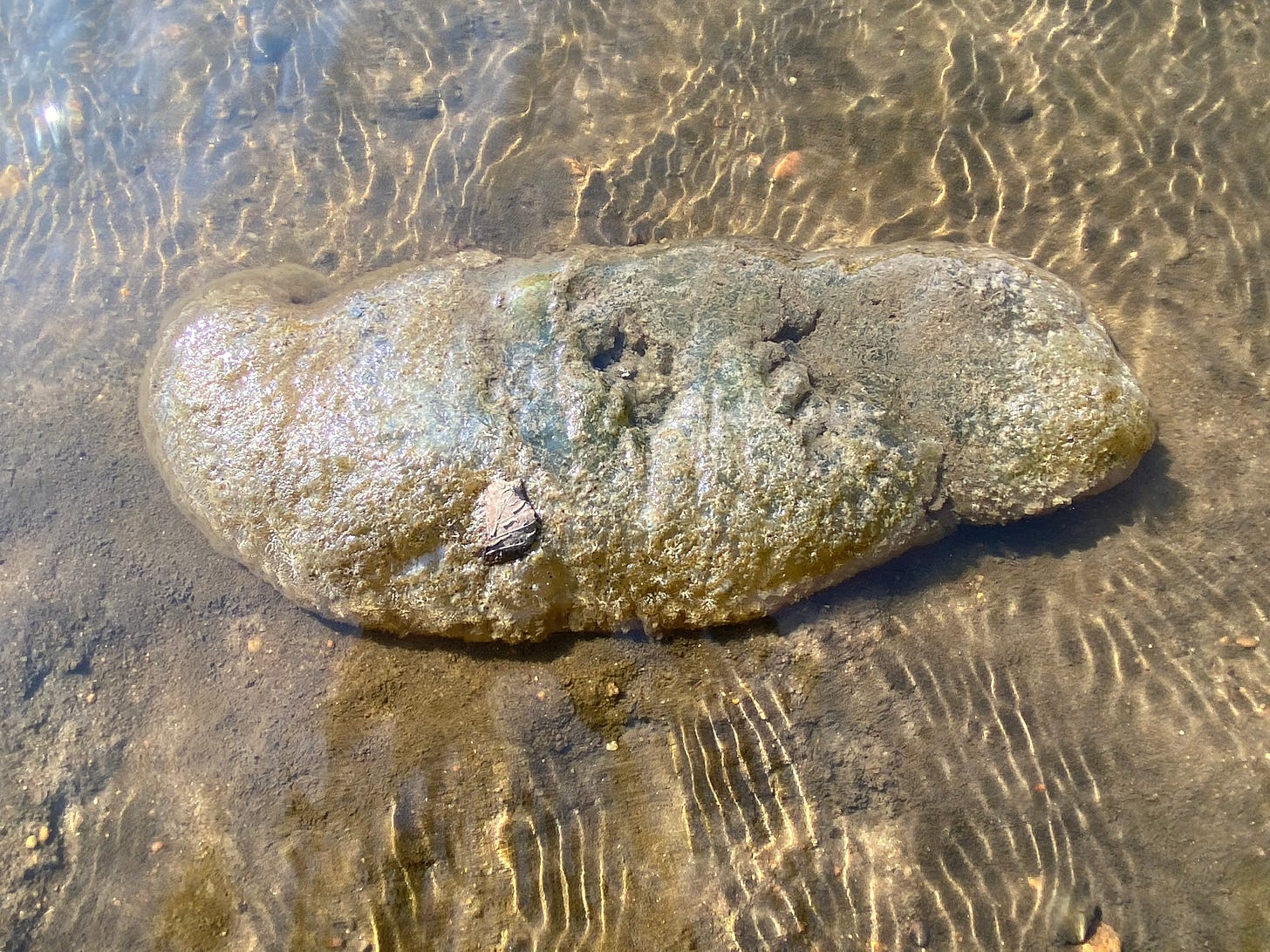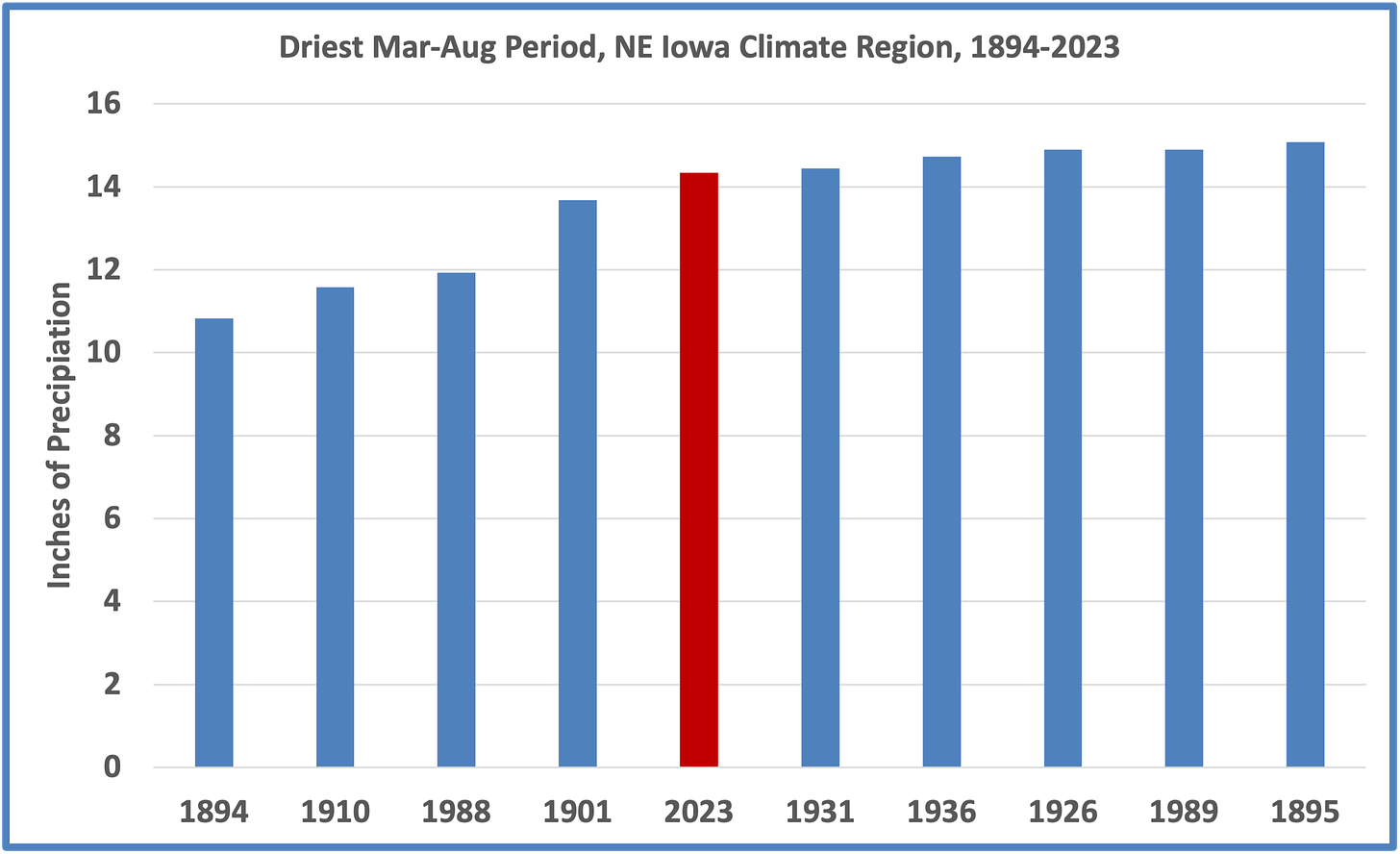It’s been very dry and you might recall from my last post that Quasquetonian Orlan Love reported a very low flow from the Wapsipinicon River at Independence on August 21st. He also told me that colonies of Bryozoa, Pectinatella magnifica, have emerged in the Wapsi, his bellwether for droughtweather. Bryozoa appeared in 1988, 2012, and briefly late last year; ’88 and ’12 both were years of extreme drought in Iowa.
So, what are Bryozoa? Although they may look like a moss or a plant, they actually are invertebrate animals that feed by filtering plankton and other microscopic organisms from the water, much like clams and mussels. A colony may consist of thousands of individuals that attach to rocks and other surfaces. They can reproduce in multiple ways: sexual reproduction to produce larvae, asexual reproduction through budding (cloning of themselves, essentially) and via the production of statoblasts which are groups of cells which act like seeds, allowing the species to overwinter in cold climates.
There are nearly 6000 species of Bryozoa but only 50 live in freshwater. As the name implies, Pectinatella magnifica is the biggest in this neck of the woods, with colonies growing to masses of 2-3’-long ovals or possibly larger in some cases. The species’ range extends east from Mississippi River tributaries to the east coast.
They seem to thrive in clear and slow-moving water, the former being something few of our warm water streams have. The Wapsi is one, however, at least at certain times of the year and especially in drought. In an examination of overall water quality at 40+ Iowa stream sites I conducted a few years ago, the Wapsi above Independence was the best stream in the state from 2014-2020 and the second best for the period 2000-2020, this mainly due to its low turbidity (high clarity) and low E. coli numbers.
Just how dry has it been?
I looked at precipitation data for the Northeast Iowa climate region (the Upper Wapsi flows through the western part of the NE Iowa Climate Region) and indeed it has been very dry since March 1. Every month since then has seen below normal precipitation (1 in 64 likelihood of this happening at random) and since 1894, the 2023 Mar-Aug total has been 5th lowest and lower than any of the 1930s Dustbowl years. From March 1 to August 31, rainfall totaled 14.34”, which is more than 11” below the 30-year (1991-2020) average.
River discharge (flow volume) records for the Wapsi at Independence date back to 1934, and believe it or not, average discharge since March 1 and June 1 are not that low compared to the historical record. Since March 1, average discharge for the year ranks 51st lowest out of 90 years and since June 1, 26th lowest. This clearly is due to abundant winter precipitation feeding the shallow aquifers that connect to the river. The August flow data, however, show the legacy effect of this winter water being tapped out; last month’s flow was the 8th-lowest for August since 1934.
Early this morning I rode the bass bike down to the Iowa River (in Iowa City) to see if I could yank out a couple channel cats, and I was astonished at how low the river has gotten. Flow this morning was 142 cubic feet per second, barely more than the record low for the date of 124 CFS set in 1959. The average flow for this date (9/3) is 1870 CFS. This is about 92 million gallons per day, but bear in mind that 3300 square miles drain to this site. The video below shows the entirety of flow coming from those 3300 square miles.
And unlike the Upper Wapsi, there are some significant wastewater treatment plant discharges on the Iowa River upstream of the gaged site (Coralville, North Liberty, Marengo, Marshalltown, Iowa Falls, Eldora, Tama/Toledo) and thus some of that 92 million gallons can be sourced back to flushed toilets and treated wastewater discharges. An educated guess is that those communities combined are discharging about 5-10 million gallons per day of treated wastewater to the Iowa River. Considering that Iowa City is using shallow wells under the influence of the river, and the University of Iowa drinking water treatment plant is using Iowa River water directly, this illustrates the importance of sound wastewater treatment, especially in low flow conditions.
Sources:
Iowa State University Environmental Mesonet, link.
U.S. Geological Survey, Current Streamflow conditions for Iowa, link.
Clemson University Cooperative Extension, Freshwater Bryozoan, link.
About my book: The Swine Republic is a collection of essays about the intersection of Iowa politics, agriculture and environment, and the struggle for truth about Iowa’s water quality. Longer chapters that examine ‘how we got here’ and ‘the path forward’ bookend the essays. Foreword was beautifully written by Tom Philpott, author of Perilous Bounty. Get a free copy of the book with an annual paid subscription to this substack ($30 value).








Big Farms and Flawless Fries Are Gulping Water in the Land of 10,000 Lakes
When Minnesota farmers cranked up their powerful wells, they blew through state limits. Thirsty crops included corn, soybeans and perfect, fry-friendly potatoes.
https://www.nytimes.com/interactive/2023/09/03/climate/minnesota-drought-potatoes.html?unlocked_article_code=INCS8Gy7yPP9SazTaQZf-yjF4TCrbztghgXlx0IjH_thPv0DScfRtyw4nQYoz47oQlz5pztSEPkXWC3pRJW6Jv8Mm9jy1YTI5KZxLfVJowMCTra4M2GeW4GQga0TeDUU8NqAwUhXAv3z13O836Z2JRGcuPoMi5Q3A6vkITz00a7xuNp_H76JUHPnCQUfK6gC66lH20lZym-2BuHzG45UhfmSqBnNME6gbjLmLkh5QD_hVO6vWX-V8L1gzcPWeQgdrF94gjg33mdJ2aNcV4aBzZNsxf2omOYEHX5sjxCdHsg20zkAIWMnRtaE0wZeDS2ZgDiQeh-sUJYX7-uBTJj08xJ2R3UeWqiyhSjf4ArgtCE7JPFQ&smid=em-share
I certainly understand the truth of it, but something about relying on toilet flushes and treatment plants to keep our rivers flowing just seems - - incredible? (Probably a better word that I'm not thinking of.) And thinking about THAT water being cleaner than what is coming off of most ag acres seems even more sad and strange.
Finished your book and I have re-read a few chapters. Thanks much for your work on it Chris! I have been recommending it to friends and will forward my copy to someone that can benefit from reading it.